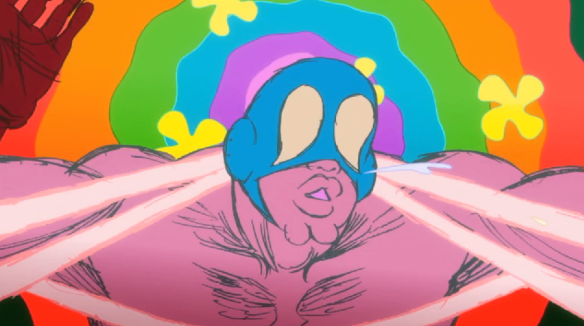
As promised, I’m going to review a newer anime today rather than sticking to the decade of my birth like my last few entries. This short film is one that many people have probably not heard of before, as it was created via a “crowd funding” project. About a year ago, I found a film called Kick Heart by Masaki Yuasa and Production I.G. on Kickstarter. Mr. Yuasa is of course the man behind the surreal (and pretty much awesome) short film Cat Soup, so I knew I just HAD to back the project. It doesn’t hurt that I’m also a huge pro wrestling fan either! It eventually made it’s required money, but missed it’s “stretch goals” which would have potentially moved the project into a feature length film, but what we got was pretty awesome none-the-less.
The story follows a man named Romeo Maki as he tries to get by with a fairly surprising dual life. Romeo works as both a masked professional wrestler and the CEO of a rundown orphanage. He funds with orphanage via proceeds from his night job, but things aren’t looking good. Lately the roof has been leaking non-stop, and it appears that a large snake has taken the children’s restroom as his home. In desperation, Romeo enters a $50,000 “winner takes all” contest against another masked wrestler named Lady S, but things get weird real quick. Lady S “gets off” by inflicting pain on her opponents, and Maskman M (Romeo) get’s the same pleasure from receiving pain. I know this sounds like the makings of an adult film, but don’t worry, Kick Heart is pretty much PG-13. Oh yeah, I forgot to mention that Lady S also works at the orphanage as a quiet young nun named Juliet, but Romeo doesn’t realize this.
The animation in this film is pretty nice, and resembles those old Bill Plympton cartoons more than any anime I’ve ever seen. Everything is sort of “sketchy” and VERY brightly colored, which really helps this film have an “edgy” or “underground” feeling to it. It’s almost like something that would have aired on MTV’s ancient Liquid Television show really late at night. I enjoyed the fact that you never got to see Romeo’s face completely, this was mostly because he lived most of his life as a masked wrestler, and tradition generally goes that such performers are never to be seen in public without their masks on. Romeo, in businessman mode, always has a black censorship bar over his eyes, a little touch that gives this film something different that really makes it stand out.
The character designs are pretty awesome and some are even borderline grotesque. Lady S’s tag team partner, in particular, is a giant of a woman that is so large that she crushes a portion of the audience when she is defeated in one of their bouts. The cool thing is that because of this, no two characters look the same, and are “larger than life” just like how pro wrestling characters generally are.
I love what Kickstarter and other crowd funding services could potentially bring to the anime market. Films like this or the recent Bubblegum Crisis Blu-Ray release are products that most likely would not have been produced in the current anime market, so pre-ordering these projects beforehand really lessen the risk of the project being unsuccessful, and guarantees the releases. Eventually I want to see more experimental films like this, and maybe older anime getting put up. It really could change the landscape of the whole industry.
Here is a trailer:
Related articles
- Animated Short Film: ‘Oru Burus’ (disinfo.com)
- Animated Short Film: ‘Oru Burus’ (rinf.com)
- Short Films Review (kaz021.wordpress.com)
- Short Film: Windmills (geeknative.com)
- Indian short film Kush among 10 Oscar hopefuls (kings4group.wordpress.com)
- The Battle of Short Films: Signs vs. Paperman (brandsandfilms.com)
- Short Film: Short, but powerful (chunkylife.wordpress.com)
- Short film: Lil Guardian Pyro (geeknative.com)
- Short Film Reviews (karanpalsingh.wordpress.com)
- Top 10 Career Starting Short Films (kiriyama23.wordpress.com)





